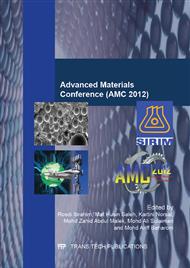p.184
p.191
p.199
p.206
p.213
p.218
p.224
p.230
p.237
Mechanical Properties and Microstructures of WC-Co Cutting Tool Inserts with Addition of VC
Abstract:
The mechanical properties and microstructures of WC-Co are highly dependent on its cobalt content, grain size of the WC particles and sintering temperature. In this work, the effect of addition of VC powder on the mechanical properties and microstructures during the consolidation of process will be investigated. The WC-Co and WC-Co-VC cutting tool inserts were fabricated using powder metallurgy route. The powders were wet mixed with heptane in turbula mixer for three hours, dried and then granulated. The mixed powders were uniaxially pressed at a pressure of 625 MPa and cold-isostatic pressed at a pressure of 200 MPa. The compacted samples were sintered in the temperature range of 1350 1450°C under nitrogen-based atmosphere. The mechanical properties of the samples are analyzed using Vickers microhardness tester, universal tensile machine and the microstructures of the sintered sample were observed using field emission scanning electron microscope. Microstructural examinations showed that VC particle is good as grain growth inhibitor as a result of good precipitation of VC in WC grain boundaries. However the addition of VC in WC-Co hardmetal resulted in the reduction of hardness and transverse rupture stress due to increase of pores in the microstructures of sintered samples.
Info:
Periodical:
Pages:
213-217
Citation:
Online since:
January 2014
Authors:
Keywords:
Price:
Сopyright:
© 2014 Trans Tech Publications Ltd. All Rights Reserved
Share:
Citation:


